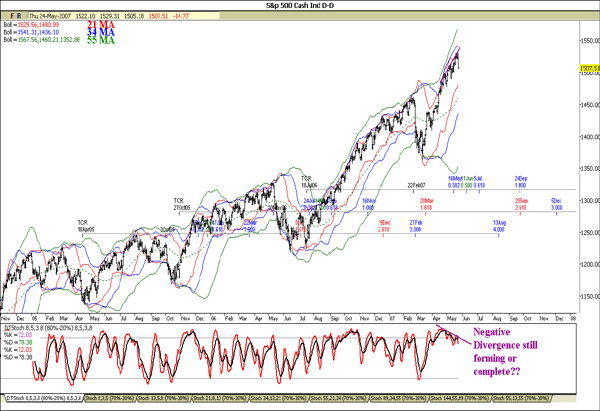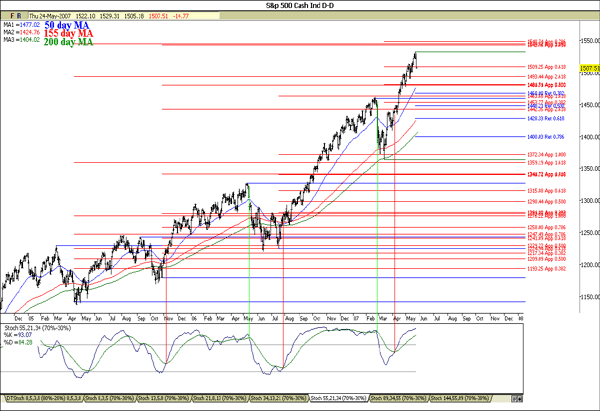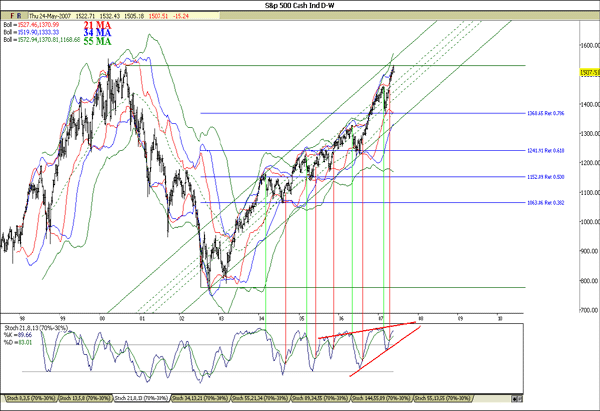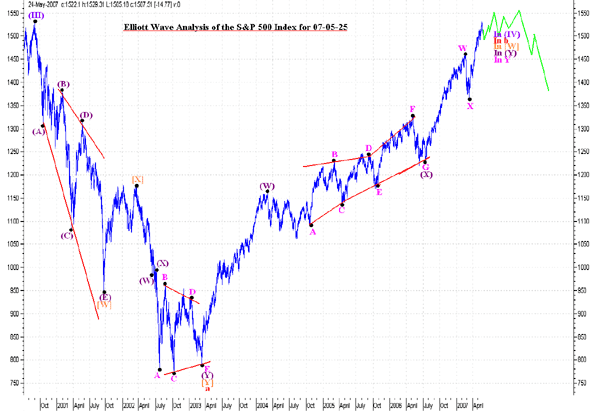Stock Market Developing Topping Pattern Over the Summer
Stock-Markets / US Stock Markets May 29, 2007 - 06:30 PM GMTBy: David_Petch
 The decline in the S&P 500 and other broad market indices likely was a shot across the bow for what lies ahead later in the year. Technically the S&P could have completed the move up, but technical evidence suggests that a topping formation will develop over the course of the summer before a sharp decline in September/October.
The decline in the S&P 500 and other broad market indices likely was a shot across the bow for what lies ahead later in the year. Technically the S&P could have completed the move up, but technical evidence suggests that a topping formation will develop over the course of the summer before a sharp decline in September/October.
The upper 55 MA Bollinger band is still rising, suggestive a top has not yet been confirmed; the lower 55 MA BB has curled up to confirm a top is in so at some point over the next few weeks, the upper 55 MA BB should curl down. Notice how low the lower 55 MA BB is in relation to the lower 21 and 34 MA BB's; given the depth, it is unlikely that we are going to witness a crash but rather a topping formation lasting until late August/September.
Fibonacci time extensions of various waves are shown mid chart, with September 24 and 25 overlapping. This overlap sets up the possibility for a point in the future where the S&P begins to break down. Short-term stochastics have the %K beneath the %D, with a negative divergence that has persisted for the past 7 weeks. Given the technicals, it appears the S&P has further downside to approximately 1480 before grinding higher and remaining range bound over the course of the summer.
Figure 1

Red lines on the right hand side represent Fibonacci price projections of upward trending wave price action projected off their subsequent lows. Blue lines represent Fib price retracements of the move from the March low until the recent high. Areas of line overlap form Fib clusters, which indicate important support/resistance levels. The S&P has found support at a Fib level, with a lower Fib cluster around 1480 (the likely low for the current decline). Moving averages are in bullish alignment (50 day MA above the 155 day MA above the 200 day MA), with the 50 day MA acting as support at 1477.02.
Full stochastics have the %K above the %D with no sign of a crossover. When a crossover occurs, it will indicate a top has firmly been put in place. Given the powerful uptrend in the S&P, it makes stating a definitive top is in place impossible. Minimally, the pattern presented in Figure 4 is complete, but the pattern could develop into a complex triangular formation. Many people are now trading the S&P at the same angle and when this occurs, the complexity of the patterns only rises. I still would not recommend anyone short the market because the whipsawing action could result in substantial short-term losses. Playing with puts, calls or shorts should only be done with money you would use on a trip to Las Vegas.
Figure 2

The weekly S&P 500 chart is shown below, with Fibonacci price retracements of the decline shown on the right hand side (denoted in blue). Notice how the S&P has moved within Fib channels since late 2003; every time the S&P broke to a higher Fib level, it eventually back-tested the breakout before going higher. The S&P fully retraced the decline from where I start the Elliott Wave count, further confirming the move likely has terminated. Just because the S&P has put in a top does not necessarily mean a crash is going to occur.
Figure 1 showed how low the lower 55 MA Bollinger band was relative to the index indicative a topping formation is likely to develop. The lower 55 week MA Bollinger band is at 1168.68, down from last week's value of 1170.97; there is no confirmation with the weekly lower 55 MA BB that a top is in (it likely will be a lagging indicator). Full stochastics have the %K above the %D within the confines of a rising stochastic wedge. Should the %K fall beneath the %D, it will confirm a top has been put in place.
Figure 3

The mid-term Elliott Wave chart of the S&P 500 Index is shown below, with the thought path indicated in green. I have not provided any labeling scheme for the current decline due to there being 5 distinct ways of labeling the pattern. The S&P should decline to around 1480 before bouncing higher. Expect the S&P to remain within a trading range of 1400-1550 over the course of the next 2-3 months before a fall correction. If the S&P has an impulsive move from 1480 to 1450, then that would require the mid-section of the chart to be labeled as a flat (3-3-5) (the current move up would represent the terminal portion of the flat). The S&P pattern is extremely complex, so if one has a hard time following this, no worries, just remember the possible ways the pattern can develop.
Figure 4

The long-term Elliott Wave chart of the S&P 500 Index is shown below, with the thought pattern forming denoted in green. The expected pattern is a topping formation and I am still formulating how to label the lower Degree pattern. Due to the minimum of 5 different ways to label the pattern, it suggests it is not yet complete. The Elliott Wave count up to Minor Degree (denoted with pink lettering) is accurate, but the lower Degree must be kept in an open reading frame until further wave structures better define the pattern.
Figure 5

By David Petch
http://www.treasurechests.info
The main focus of my work pertains to analysis of the USD index, S&P 500 Index, 10 Year US Treasury Index, AMEX Gold BUGS Index and the AMEX Oil Index using market analysis specified in a former article I wrote titled “The Technical Palette” (Elliott Wave, Bollinger bands, stochastics). We also cover around 30-40 gold/silver, base metal and energy stocks, which have done quite well recently. If this is the kind of analysis you are looking for, we invite you to visit our new and improved web site and discover more about how our service can further aid you in achieving your financial goals. For your information, our new site includes such improvements as automated subscriptions, improvements to trend identifying / professionally annotated charts, to the more detailed quote pages exclusively designed for independent investors who like to stay on top of things. Here, in addition to improving our advisory service, our aim is to also provide a resource center, one where you have access to well presented 'key' information concerning the markets we cover. And if you have any questions, comments, or criticisms regarding the above, please feel free to drop us a line . We very much enjoy hearing from you on these matters.
Copyright © 2007 treasurechests.info Inc. All rights reserved.
Unless otherwise indicated, all materials on these pages are copyrighted by treasurechests.info Inc. No part of these pages, either text or image may be used for any purpose other than personal use. Therefore, reproduction, modification, storage in a retrieval system or retransmission, in any form or by any means, electronic, mechanical or otherwise, for reasons other than personal use, is strictly prohibited without prior written permission.
Disclaimer: The above is a matter of opinion and is not intended as investment advice. Information and analysis above are derived from sources and utilizing methods believed reliable, but we cannot accept responsibility for any trading losses you may incur as a result of this analysis. Comments within the text should not be construed as specific recommendations to buy or sell securities. Individuals should consult with their broker and personal financial advisors before engaging in any trading activities as we are not registered brokers or advisors. Certain statements included herein may constitute "forward-looking statements" with the meaning of certain securities legislative measures. Such forward-looking statements involve known and unknown risks, uncertainties and other factors that may cause the actual results, performance or achievements of the above mentioned companies, and / or industry results, to be materially different from any future results, performance or achievements expressed or implied by such forward-looking statements. Do your own due diligence.
© 2005-2022 http://www.MarketOracle.co.uk - The Market Oracle is a FREE Daily Financial Markets Analysis & Forecasting online publication.


